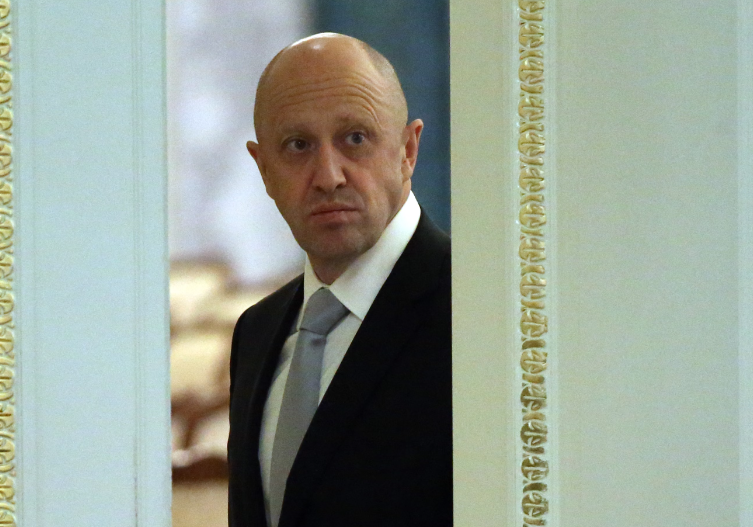The Grisly Cult of the Wagner Group’s Sledgehammer

IN THE LONG, terrible history of the Syrian civil war, a 2017 video of a war crime committed by Russian mercenaries still stands out for its horror. The videotaped torture and murder of Hamadi Bouta, a Syrian Army deserter, by members of the notorious Russian-led Wagner Group generated global outrage as well as a legal case against the paramilitary organization. The footage of Bouta being beaten to death with a sledgehammer before his body was beheaded and set on fire rivaled the worst atrocities publicized by the Islamic State. Yet the film did not horrify everyone who saw it.
Among members of the Wagner Group and its supporters, the video of Bouta’s murder has given rise to a culture glorifying violence against noncombatants that is explicitly centered on the symbol of the sledgehammer. This cult is now being embraced by leaders of the group, including its founder Yevgeny Prigozhin, who have turned the sledgehammer into part of its brand. T-shirts and other merchandise depict sledgehammers alongside the Wagner logo, while both supporters and members of the group have taken to picturing themselves holding both real sledgehammers and replicas in photographs shared online, often while dressed in imitation of the killers from the footage.
Wagner now seems to be making the sledgehammer its official calling card. Last November, on the heels of a symbolic European Union resolution designating Russia as a state sponsor of terrorism, Prigozhin sent a sledgehammer smeared with fake blood to the European Union Parliament. That was followed by another incident in which a group of Russian ultranationalists threw sledgehammers at the Finnish Embassy in Moscow. Last month, Sergei Mironov, a Russian parliamentarian who heads an ultranationalist party, posted a photo of himself posing with a sledgehammer branded with Wagner’s logo atop an engraving of a pile of skulls, in yet another visual tribute to the group.
The macabre culture around Wagner Group comes at a time when it is ascendant within the Russian state and is making a strong recruiting push, appealing to foreign volunteers, including Americans, to join the group.
“A lot of the content that I see on Telegram and elsewhere is eerily reminiscent of neo-Nazi propaganda, which is an aesthetic that they seem to have copied,” said Colin P. Clarke, the director of policy and research at the Soufan Group, a global intelligence and security consulting firm that monitors Wagner activity online. “It makes sense given the audience they are trying to recruit, who are, essentially, for lack of a better word, sociopaths.”
Clarke said that Wagner’s recruiting pitch was in many ways reminiscent of the Islamic State, which had its own distinctive methods of carrying out executions and promised its fighters similar spoils — including sex slaves and property confiscated from minorities in Iraq and Syria — in exchange for their service. Similarly to the Islamic State, Wagner fighters have been accused of torture, murder, sexual violence, and looting in many areas where the group operates. Its brutality is increasingly seen as part of its sales pitch to potential clients, particularly in weak and failing states where governments are unconcerned with human rights abuses.
“As long as you go in and get the job done, no one is going to ask any questions about how you behave,” Clarke said, commenting on the culture promoted to recruits of the group. “That’s part of their brand right now.”
THE CREATION OF a cult of violence in wartime is not a uniquely Russian pathology. During the U.S.-led global war on terrorism, certain weapons, including tomahawks used by U.S. special forces to bludgeon enemies, became part of a culture glorifying death that took root among some members of the military and on the right-wing fringes of American society. The ubiquity today of the Punisher logo, popularized during the wars and now common among police officers domestically, is yet another legacy of the war’s cultural impact at home.
The U.S. also employed private military contractors during its conflicts, most notoriously the company formerly known as Blackwater, and many of them also engaged in crimes during the wars in Iraq and Afghanistan. Despite their brutality, however, none of them matched the political prominence of Wagner, which is rapidly becoming an integral part of Russian foreign policy. In addition to its role in Ukraine, where the group is said to field thousands of fighters, including prisoners convicted of serious crimes like rape and murder who have been offered a chance to fight in exchange for their freedom, Wagner mercenaries are now active across Africa and the Middle East. In those regions, the mercenaries enforce Russian foreign policy goals even as their private military contractor status provides a measure of plausible deniability. In countries like Mali, Libya, and the Central African Republic, Wagner mercenaries have been accused of participating in war crimes and exploiting natural resources as part of lucrative security arrangements with local leaders.
In a system where power is largely centralized around President Vladimir Putin, Prigozhin, an ex-convict who formerly worked as contractor providing lunches for Russian schools, has emerged as a political force in his own right, becoming the focal point for ultranationalist sentiments even more extreme than those represented by Putin and feuding with members of the military elite. In some quarters, Prigozhin and his group are even rumored to be possible challengers for power.
“The post-Soviet Russian state has always had two facets: the criminal element which Prigozhin represents, and the intelligence and military bureaucracy,” said Chris Elliott, a Ph.D. researcher at King’s College London focused on the study of political violence and war crimes. “Wagner becoming a more important tool of Russian foreign policy is really about the increased importance that criminal element has in pulling the levers of the state.”
In that light, the culture of the Wagner Group and its embrace of ultraviolence, with the sledgehammer as its symbol, sends a chilling warning about the trajectory of Russia under its present regime. The sledgehammer is not merely a symbol either. Late last year, the Wagner-linked Telegram channel Grey Zone posted a video of a defector from the group who had attempted to join Ukrainian forces being murdered with a sledgehammer in a manner similar to Hamadi Bouta. The video was posted along with an approving comment from Prigozhin, saying that the executed man had received “a dog’s death for a dog.” As the group ramps up its operations around the world, this is unlikely to be its last snuff film.
As one Russian oligarch reportedly put it, speaking on the growing culture glorifying violence around Wagner and its rise within a Russian state where criminals increasingly call the shots, “the sledgehammer is a message to all of us.”










